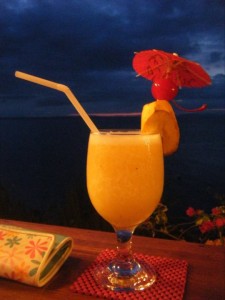 ‘Gorgonians, black coral, shells, turtles, rays, grunts, jacks, snappers, and… soft corals.’ Luscious names that rolled off the tongue and tempted us to dessert the shopping malls of Metro Manila, rest our blistered feet and explore further afield. My husband suggested Eagle Point, a remote, unassuming resort near Anilao, Batangas.
‘Gorgonians, black coral, shells, turtles, rays, grunts, jacks, snappers, and… soft corals.’ Luscious names that rolled off the tongue and tempted us to dessert the shopping malls of Metro Manila, rest our blistered feet and explore further afield. My husband suggested Eagle Point, a remote, unassuming resort near Anilao, Batangas.
It was mid-November. My daughter, her best friend and I had left Sydney with post HSC burn out, to join the rest of the family in Manila. The city was great fun, but not the R&R we really needed. Anilao sounded like a perfect retreat. We set out two days later armed with books, bathers, snorkel, goggles and my computer, as I would need to write smug emails to all my friends about life on a tropical island and cocktails by the pool.
On this, our first foray out of Metro Manila, our eyes were glued to the windscreen for the entire trip. Shop houses, rice farms, goats and caribou, provided a very different vision of the Philippines to the one from our 32nd floor apartment. We loved the brightly decorated jeepneys and marvelled at how many people could squeeze into the low slung side cars of the motorcycle taxis.
Anilao is a brightly painted town hanging off the edge of a narrow, lush peninsula in southern Batangas. It is also a popular and accessible diving area, less than three hours drive south-west of Manila. A shuttle service can ferry tourists to and from Manila airport, but for locals it’s an easy drive, with parking on the road above the hotel and a hair-raising jeepney ride down the cliff.
It is a good idea to buy a package that includes all meals as access to other restaurants is limited. Luckily, the hotel menu proved to be surprisingly varied – for a short-term visit at least – and the bar was well stocked.
Eagle Point is not a high end resort, despite its claim to five stardom – if you are looking for luxury accommodation and kids clubs you may need to look further afield – but there is a water-slide, two split-level pools and a salt-water diving tank filled with grouper, baby sharks and a shy turtle that hides amongst the rocks. We never found the games room, but apparently it has a dart board, table tennis and billiards; there’s an in-house masseuse and a tiny gift shop. A number of old aviaries houses some rather large birds including a horn bill and an eagle which may interest the kids.
We had been warned not to expect too much, so the rooms exceeded our expectations: simple, attractive and clean. Just make sure you are housed in the new part of the hotel and not in one of the old chalets. These were dark and run down and received a scathing review from one unhappy blogger!
While the girls relaxed by the pool, I set up house in the open air dining room with its panoramic views across the bay. (Well, I had all those emails to send!) With window boxes brimming with pink bougainvillea, a sea breeze drifting through wide open shutters and waves lapping gently below, I was in heaven. I discovered freshly squeezed kalamansi juice, ‘syrup-on-the-side, and the staff cheerfully armed me with a bottomless coffee pot. I typed happily for hours, distracted only by a rowdy gecko drunkenly chirping above the bar.
The beaches are not really beaches as we Aussies know them, unless you are familiar with England’s Brighton beach. Unlike Brighton, this rocky coastline is barely tidal, so the waves lap against the rocks mere metres from our balcony. Hiding beneath the waves, right in front of the hotel, is a stretch of protected reef.
According to the website, the house reef was discovered several years ago by a British team of marine biologists. It is made up of ‘287 species of corals compared to only 50 species in the Caribbean and 250 species in our world-famous Tubbataha Reef in the Sulu Sea.’ So the area is popular, not only with amateur snorkelers like me, but also with trained divers.
Snorkeling and scuba diving are Eagle Point’s main attractions. A dive shop concession stocks all the necessary equipment and internationally accredited diving courses are offered by qualified instructors. It is possible to dive here all year round, though, between July and September typhoons can cause choppy waves and poor visibility.
I have to admit I am not the bravest of swimmers, and was unenthusiastic about diving, but Eagle Point is an easy, unthreatening place to start: visibility is good, the sea is warm and there is a lot to see – although I was convinced that the rubbery-looking electric blue starfish had been strategically placed on the reef for our entertainment.
Having gained a little confidence close to home, we spent Day Two sailing out past Sombrero Island to Sepoc Point. Sombrero Island provides excellent diving, but you need to beware of strong currents. Unfortunately, the coral reef off the beach at Sepoc Point looked like a graveyard. Apparently a lot of the local reef has been badly damaged by explosives used for fishing and, sadly, old rubbish is all too visible. Nonetheless, the prolific reef fish (or ‘Nemo’ fish, as my daughter called them) kept us engaged for hours.
Our guides then cooked us a wonderful seafood barbecue on the beach, and as always it tasted better for the fresh air. Afterwards, we decided what we most craved now was ice cream. We headed back, happy and sun burnt, to the hotel fridge full of Haagen-Dazs.
